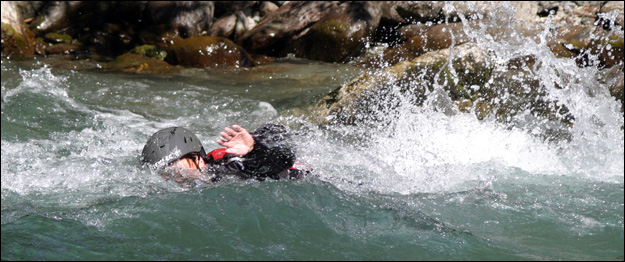
Instructor tips - The whitewater swimming position
At the beginning of the season I picked up a customer from another company who was happily floating down the Imsterschluct in the whitewater swimming position, despite the raft having paddled off in the other direction to rescue another customer, who was doing the same.
It still amazes me how many raft guides only emphasize the white water swimming position (also know as defensive swimming) to their guests even when they raft on continuous rivers like we have here in Austria.
Don't get me wrong the white water swimming position is great when the river is shallow or rocky, particularly when rocks are sticking out of the water. It also ensures that the guests have their feet on the surface and are not trying to stand up. However in most situations, particularly at high water, the most effective rescue is for the guest to self rescue by actively swimming to the raft or if the raft is too far away to the bank.
As long as the guest still keeps their feet on the surface and there are no rocks sticking out of the water then they will not get injured and the rescue will be quicker. In situations where there are multiple swimmers this makes it both easier and quicker for the guide to get everyone back in the raft. The guest has the advantage that as soon as they are holding onto the sideline of the raft they will stay on the surface a lot more in waves making it easier for them to breath.
All too often at the put in I over hear guides saying "Always swim back to the raft. Never swim to the bank." Well never is a very long time, and over the last 20 years guiding I've been in a few situations where it was a very good thing that a customer decided to swim to the bank and not wait for the guide to do something. Generally the raft will be closer to the guest after they have fallen out of the raft, so it makes sense for them to swim the two or three meters, rather than fifty meters to the bank. Also if they get to the bank then the guide has to stop their boat and walk back upstream to find them. Not always an easy task and on some gorges almost impossible. So it is easy to understand why guides come out with these statements.
Anytime a raft gets stuck, regardless of it it's on a rock or in a hole, if guests fall out they can be a long way from rescue even on a multi boat trip. Seeing them float off in a nice defensive swimming position is not what you want in this situation unless there is a guide in position to effect a rescue immediately downstream. If they try and swim back to the raft they will use up a lot of energy swimming against the current, energy that could of been used to better effect swimming to the bank.
So next time you are giving a safety talk at the put in for a river trip think about what you really want your guests to do in emergency situations, and start to emphasize that.